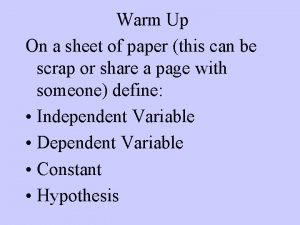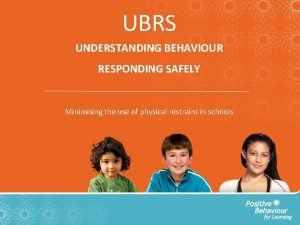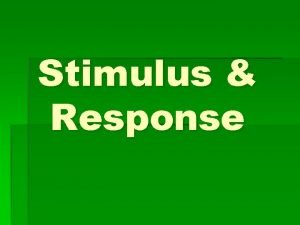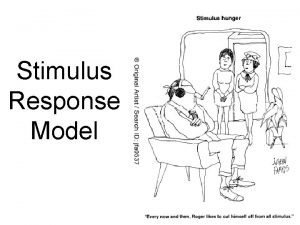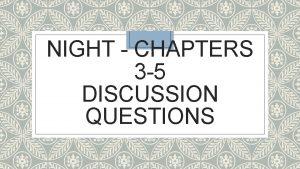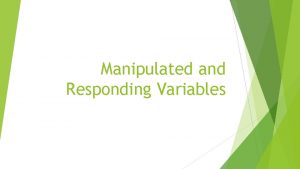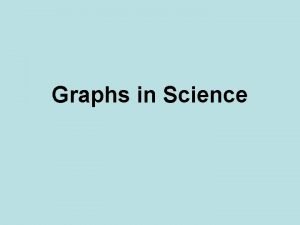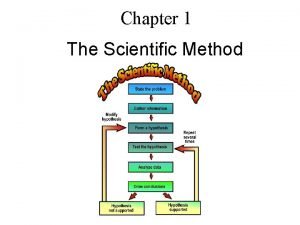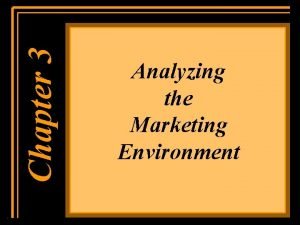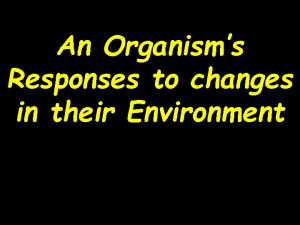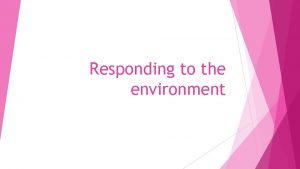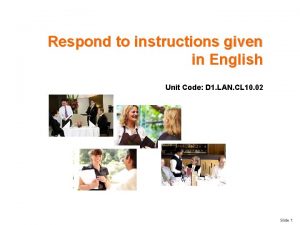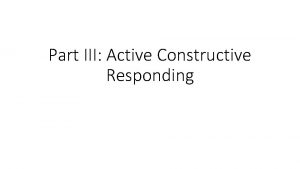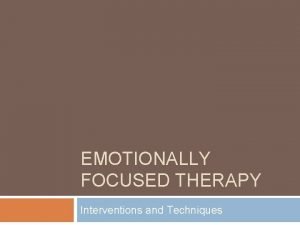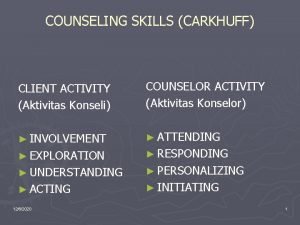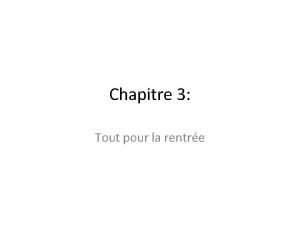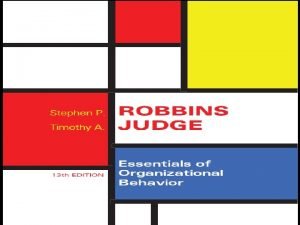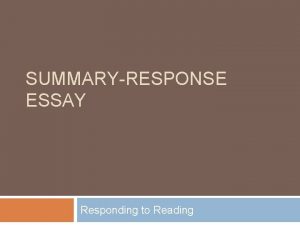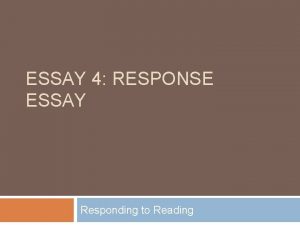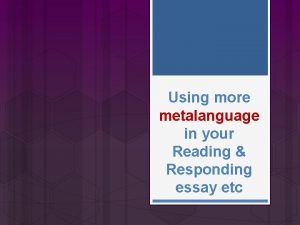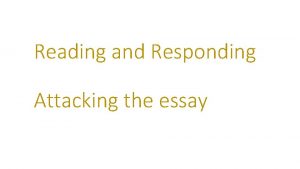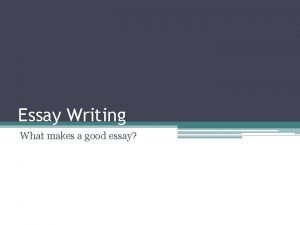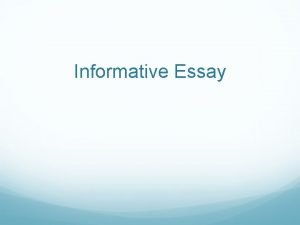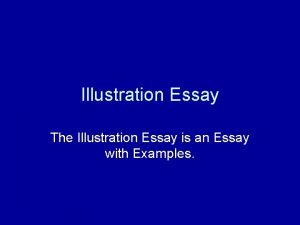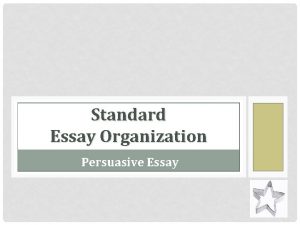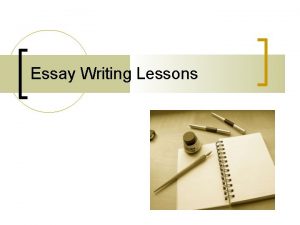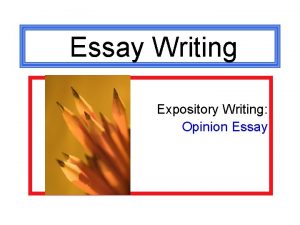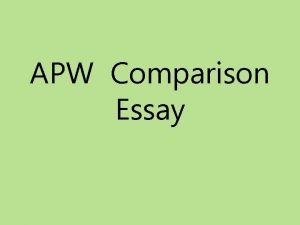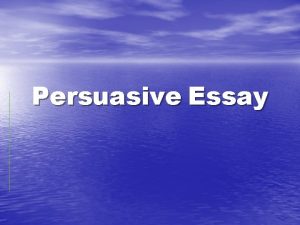SummaryResponse Essay Responding to Reading Purpose of this






















- Slides: 22

Summary-Response Essay Responding to Reading

Purpose of this Essay To understand an author’s main idea and purpose for work To recognize the main points that support that main idea To be able to summarize(paraphrase) author’s main ideas To be able to respond or react to what the author has to say (to support or defend your point of view)

Reader Demands Clear text Logical thoughts and arguments Reliable, credible information Thoughtful and thought provoking Honest writing Often objective, non biased or well supported argument

Other Reader Demands Readers want to know about the author, his background, experience, expertise Occasion, purpose, audience of writing situation Cultural context Writer’s claim or argument Logical use of evidence, adequate evidence Style, voice, tone, word choice

Reading Critically Not about finding fault with author Rather engaging author in a discussion by asking questions as you read an article or essay Requiring author to meet certain demands that employ good writing techniques Notice where main idea is Notice how that idea is supported in the paper; what kind of evidence is used as support

Critical Reading Guide -take note of: Purpose Audience, reader Occasion, genre, context Thesis and main or supporting ideas Organization and evidence Language and style Tone Credibility of author

Introduction Will Include: Title of the article or essay and name of author; make sure to spell correctly Any key information you might know about author to help establish author’s credibility State author’s main idea – not details Thesis: a well thought out statement stating your main point about the article or essay.

Example of an Introduction: In her essay “The Way Men and Women Use Language ”, author Deborah Tannen argues that teachers should be aware of the vast differences in how men and women communicate in order to be more successful in the classroom. She claims that this awareness would improve teaching practices and student learning. Based on my experience in the classroom as a woman, I have to disagree with Tannen; communication styles do not affect students’ ability to perform successfully.

Summary Portion Cite the author and the title of the text Spell correctly! Indicate the main ideas of the text Paraphrase main ideas; quote sparingly, use key words, phrases, and sentences Include author tags Avoid summarizing specific details or data Be objective

The Summary: does not include your own opinion or response does include all the points Pipher makes What are her main points? Make a list on your outline: 1. 2. 3.

Response Portion Your opinion of the author’s ideas Present your reaction to the reading. You can respond in one of three different ways: 1) You can agree or disagree with the author's main idea 2) You can offer an interpretation of the text; what you believe the author's text means 3) You can write an analysis of the text by discussing the quality of writing, the strength of the argument, and quality of evidence.

Structuring Your Response Requires your reaction to the text and your interpretation of the text Remember the response is your reaction to the text; and while it is your opinion, you will provide evidence and examples to support your reaction from both the text (paraphrasing and quotes) and life experience. You will use the article as a reference to frame your response, citing the source correctly in-text and on a correct MLA formatted Works Cited List

1. Agreeing or Disagreeing A response of this nature will react to the ideas or the argument Simply, do you agree with the author’s ideas? Why or why not? Provide evidence – in this essay, life experience and examples, to support your reaction: “Based on my experience with how change happens…” Try to avoid over using “I agree” and “I disagree”

2. Interpretation and Reflection Writer will explain or examine the text by looking at the underlying assumptions or implications of the author’s ideas. You may add your own experience, attitude, and observations as they relate to text

3. Analyzing the Effectiveness of the Text Use this approach if you do not have an opinion on the topic Do an analysis of the structure of the writing The clarity of the main idea Use of logic and reasoning, strength of argument Use of supporting evidence Overall effectiveness of the piece Tone and style Good writing

Two Ways to Provide Evidence to Support Your Response Your response requires that you provide evidence to support your opinion, whether you agree or disagree with the author Consider what sort of evidence will best support your statements, using BOTH: 1. Personal experience 2. Evidence from the text (article)

1. Personal Experience Use personal experience as examples to demonstrate why you interpret the text the way you do, why you react the way you do, why you agree or disagree I disagree with Pipher’s first point based on my own community experience, especially in my neighborhood. . . I agree with Pipher’s idea about…because in my experience….

2. Evidence From the Text Cite specific phrases or sentences from the text to support your : explanation of the text analysis of the effectiveness of the text why you agree or disagree

How to Use and Integrate a Source: Paraphrasing Rephrasing author’s ideas in your own words Retains the original meaning without plagiarizing Paraphrasing: requires (citation) in parentheses at the end of the sentence or section. Direct Quotation: Presents author’s words exactly as stated in the text. Introduce with an author tag – just LAST name Enclose in quotation marks – they come in pairs! Cite page number () at end of quotation How to cite on the Works Cited List: Pipher, Mary. Writing to Change the World. New York City: Riverhead Books, 2006. 1 -4. Print.

Respond to each point: Make sure to give reasons why you disagree Give examples from the text, personal experience, facts, any previous experience or knowledge you can draw upon to support your opinion Points you agree with (list) 1. 2. 3 Points you disagree with (list) 1 2 3 Cite correctly in the paragraph and Works Cited List

Conclusion wrap up the paper with your main idea of your response to Pipher’s paper think about the issues that affect your community if you were to “write to effect change”, what would you write about? To whom?

Organization: Outline Patterns: Block 1. Introduction with author/title intro and thesis 2. Summary of main points – cite text 3. Response Paragraph: a. points you agree with – why – cite from text b. points you disagree with – why not – cite from text Conclusion a. wrap up main idea of response b. your ideas for writing for change in your community
 While reading activities
While reading activities Manipulated variable and responding variable graph
Manipulated variable and responding variable graph Ubrs training
Ubrs training Responding to internal stimuli
Responding to internal stimuli Stimulus and response
Stimulus and response Chapter 4 night discussion questions
Chapter 4 night discussion questions What is a responding variable
What is a responding variable Define affective domain
Define affective domain An indirect, dishonest way to control or influence others
An indirect, dishonest way to control or influence others Why are line graphs powerful tools in science?
Why are line graphs powerful tools in science? _____ is done with the first responding officer.
_____ is done with the first responding officer. The expression of congratulation
The expression of congratulation The fourth step in the scientific method is
The fourth step in the scientific method is Analyzing the market environment
Analyzing the market environment Responding to internal stimuli
Responding to internal stimuli Responding to the environment
Responding to the environment Responding to instructions
Responding to instructions Joy multiplier
Joy multiplier Eft cycle
Eft cycle Paraverbal communication cpi
Paraverbal communication cpi Attending responding personalizing initiating
Attending responding personalizing initiating Making and responding to requests 2 bac
Making and responding to requests 2 bac Responding to globalization in ob
Responding to globalization in ob

